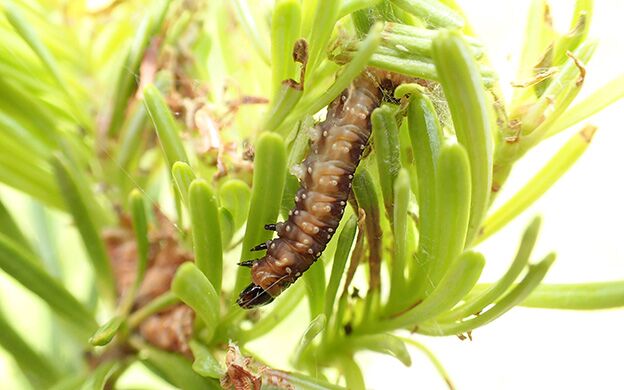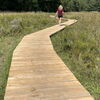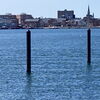Potential yearly impact of severe spruce budworm outbreak in Maine: $794M
 Photo Courtesy/ Maine Forest Service
The eastern spruce budworm — the budworm destroyed up to 21% of Maine's fir trees during the last major infestation almost 40 years ago.
Photo Courtesy/ Maine Forest Service
The eastern spruce budworm — the budworm destroyed up to 21% of Maine's fir trees during the last major infestation almost 40 years ago.
A task force created to prepare for another epidemic of the eastern spruce budworm — which destroyed up to 21% of Maine’s fir trees during the last major infestation almost 40 years ago — has released a report with 70 recommendations intended to minimize when a new outbreak occurs.
The stakes are high. According to the task force’s report released on Wednesday, the economic impact in Maine is pegged at $794 million per year during a severe outbreak and $397 million per year for a moderate outbreak.
In a news conference in Augusta on Wednesday, Gov. Paul LePage emphasized it’s not a matter of if the pest returns to Maine but when.
“We are on the verge of another spruce budworm epidemic and our goal is to lessen its damage,” LePage said at the news conference highlighting the findings of the Maine Spruce Budworm Task Force, which was led by Robert Wagner, director of the Cooperative Forestry Research Unit at the University of Maine; Patrick Strauch, executive director of the Maine Forest Products Council; and Doug Denico, director of the Maine Forest Service.
Adding some urgency to their message is the report’s finding that the eastern spruce budworm, whose populations typically reach epidemic scale every 30 to 60 years, is steadily moving southward from the Province of Quebec, where 15.6 million acres of forests were defoliated in 2015, and is now spreading into New Brunswick.
“Severe defoliation is within 50 miles of Maine’s border,” said Dave Struble, state entomologist. “We are at the start of an outbreak. We don’t know how bad it will be or exactly where, but we are seeing a build-up of budworm populations here.”
Why it matters
Here’s why the threat of another major spruce budworm infestation in Maine matters, according to the task force’s report:
- Up to 5.8 million acres of spruce-fir stands in Maine’s forest, containing 27.3 million cords of harvestable balsam fir, are at risk of defoliation.
- The projected total volume loss over the next 40 years following an outbreak, according to a 2013 model analyzing the potential impact, is 12.7 million cords from a severe outbreak to 6.4 million cords for a moderate outbreak of half that intensity.
- Maximum annual volume loss in a new outbreak is projected to be 494,000 cords per year for an outbreak of similar severity to the one that occurred in Maine during the 1970s and 1980s, and 247,000 cords per year for an outbreak of moderate intensity.
- Economic impact of those volume losses is pegged at $794 million per year during a severe outbreak and $397 million per year for a moderate outbreak, unless mitigation efforts are launched to minimize those losses.
- Job losses in the forest products sector would translate to 1,196 jobs for a severe outbreak and 598 jobs for a moderate outbreak.
“Higher total job losses would be expected due to the multiplier effect of forest products jobs,” the report stated.
Can anything be done?
The report includes about 70 recommendations, including increasing monitoring efforts, applying pesticides where appropriate, changing forest management strategies and seeking ways to pre-salvage trees that likely would be lost once the infestation begins.
Key forest management recommendations for landowners to prepare for a spruce budworm outbreak include:
- Map the location, condition and concentration of high-risk stands on their timberlands.
- Shift harvesting now and in the coming years toward marketable high-risk stands.
- Stop pre-commercial and commercial thinning within three years of the outbreak in stands where balsam fir and white spruce make up more than 50% of the composition.
- Prepare action plans to salvage (or pre-salvage) trees likely to be lost during a spruce budworm outbreak.
- Seek and encourage markets for low-value trees from pre-salvage and salvage operations.
- The task force also recommends that the state step up its educational efforts and encourage forest landowners to participate in monitoring efforts, which will help everyone understand how the outbreak is progressing and forecast where damage to Maine’s spruce-fir forests is most likely to occur.
“It’s like having a hurricane moving toward us from offshore,” said Wagner. “We know it is there, how it behaves and the kind of damage it can do. We can hope that it misses us, but if we don’t prepare for the worst, shame on us.”
“The budworm threat remains the same [as Maine’s outbreak in the 1970s and 1980s], but a lot of other things have changed,” added Strauch. “Our industry is governed by the Forest Practices Act now, pesticides are highly regulated and far more expensive, and there’s much less state and federal funding available.”
Strauch said the report “provides a framework to help landowners make good decisions” and will help them “figure out the best path forward.”
In Maine, during the last spruce budworm epidemic, up to 25 million cords of spruce-fir wood — representing 21% of all fir trees in the state — were destroyed, according to Maine Forest Service reports.
Denico, who was involved in fighting the earlier infestation, said at its height “the entire region from Ontario to Newfoundland was involved in the largest spruce budworm outbreak ever recorded.”
“We were there, in the battle,” he said. “We remember and we’ve made a commitment that we won’t be unprepared this time.”
Read more
Impact of AMC's Maine Woods Initiative: $22M










Comments